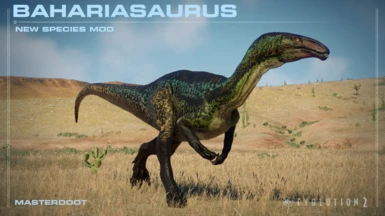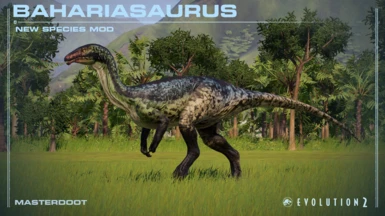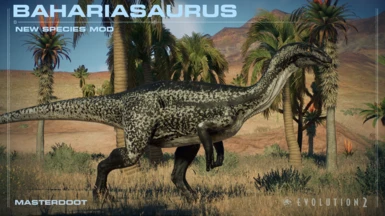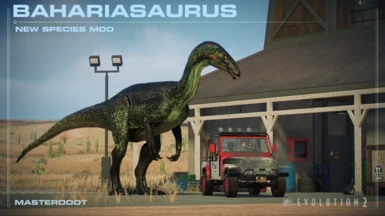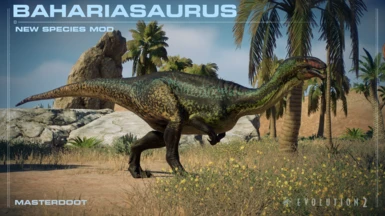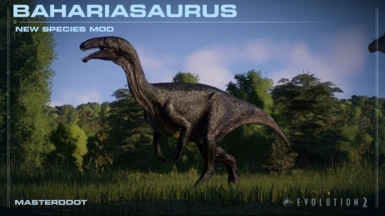About this mod
Bahariasaurs was a large theropod dinosaurs that lived in Africa during the Late Cretaceous period. It's exact classification is uncertain, as different studies have placed them in different branches of the theropod family tree. One possibility is that they are related to noasaurids, which is what this interpretation is based on.
- Requirements
- Permissions and credits
- Donations
Bahariasaurus was possibly synonymous with deltadromeus or a closely related to deltadromeus
“The form of the coracoid, femur, and the proximal ends of the tibia and fibula of D.agilis, in particular, match that of isolated material recovered from the Bahariya oasis in the Western Desert in Egypt and referred by Stromer (1934) to his theropod taxon Bahariasaurus ingens. Although Sereno et al. (1996)noted several derived features shared by these overlapping bones, they erected a new taxon Deltadromeus agilis for the Moroccan partial skeleton, because Stromer’s bones were not part of his holotypic specimen for B. ingens, they probably pertain to multiple individuals, and they have all been destroyed. Stromer (1934: 24, pl. II, figs 4, 9, 10) was explicit in designating a specimen he numbered 1922 X47 as the holotype of B. ingens. Composed of some vertebral parts, a rib fragment, a proximal ischium, and conjoined pubes, the fragmentary holotype of B. ingens differs from the Moroccan skeleton most noticeably in the shape of the iliac peduncle of the ischium and in several details of the pubes, as reported by Sereno et al. (1996: 991, note 32). Thus, the Moroccan skeleton cannot be referred to B. ingens, which we regard as a nomen dubium.
Four of Stromer’s referred bones, however, bear a striking resemblance to comparable bones in the skeleton of D. agilis. The coracoid is expanded anteroposteriorly with a subrectangular posterior process; the femur has a very similar proximal end (narrow head, prominent leaf-shaped anterior trochanter), narrow shaft proportions, the unusual accessory trochanter projecting posteriorly from the posterolateral edge of the shaft below the fourth trochanter, and a projecting anterior extension of the medial distal condyle (Stromer 1934: pl. III, fig. 5b); the proximal end of the tibia is very broad transversely across the condyles; and the proximal fibula has a very large, oval fibular fossa, a prominent anterior trochanter, distal to which it narrows rapidly to a slender shaft. We regard all of these bones as potentially indistinguishable from those of D. agilis and, for that reason, referred them to that genus and species (Sereno et al. 1996). In doing so, D.agilis became the third large theropod species shared between the Kem Kem Group and the Bahariya Formation (after Spinosaurusaegyptiacus and Carcharodontosaurussaharicus).”
https://www.ncbi.nlm.nih.gov/pmc/articles/PMC7188693/
The exact taxonomic placement of Bahariasaurus is uncertain, although it has been variously assigned to several theropod groups, including the Carcharodontosauridae[7] and the superfamily Tyrannosauroidea.[8] The smaller contemporaneous theropod Deltadromeus could potentially be synonymous with Bahariasaurus. If this assumption is correct, Bahariasaurus would possibly represent the largest ceratosaur as recent studies consider Deltadromeus a ceratosaur, specifically a noasaurid.[2] More specimens (especially the skull) would be needed to more accurately classify it and determine its relationship to Deltadromeus.
In 2016, Gregory S. Paul suggested that Deltadromeus may be a juvenile specimen of Bahariasaurus, but that their relationship is uncertain and to be determined. A 2020 study found that a referred fossil of Bahariasaurus belongs to Deltadromeus, leaving Bahariasaurus to be regarded as a nomen dubium by the authors.[10]
https://x.com/Syn_JFD/status/1449447728619077642?s=20
Plus this design is much more unique pertaining to theropods.
Bahariasaurus was a large theropod dinosaur that lived in North Africa during the Late Cretaceous period, about 95 million years ago. It is estimated to have reached about 11-12 meters (36-39 feet) in length and 5 tons in weight.
Bahariasaurus was one of three giant theropods known from the Bahariya Formation, the other three being the allosauroid Carcharodontosaurus and the spinosaurid Spinosaurus. These predators probably coexisted by occupying different ecological niches and hunting different prey. Spinosaurus was mainly piscivorous, feeding on fish and other aquatic animals, while Carcharodontosaurus was likely a specialized hunter of large sauropods. Bahariasaurus may have been more generalist, feeding on a variety of smaller or medium-sized animals, such as ornithopods, pterosaurs, and crocodilians.











